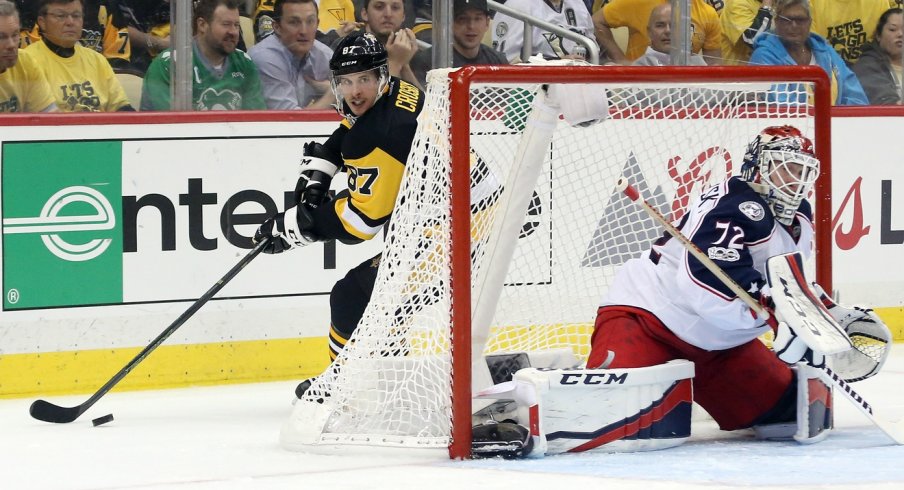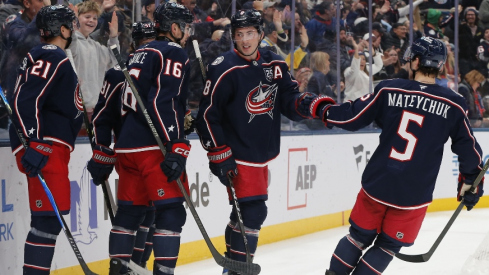This is going to be a hard piece to write.
Yes, the season being over is depressing. But more than that, analyzing this game and series feels somewhat difficult. Just looking at Game 5, the Columbus Blue Jackets threw the rubber at Marc-Andre Fleury a grand total of 72 times. Fifty-one of those shots ended up on net, netting 15 high-danger chances, yet only two went in the net.
In other words, it was the kind of series you wouldn't expect, from Sergei Bobrovsky's struggles to Markus Nutivaara scoring more goals (one) in two games than Nick Foligno, Alexander Wennberg, Sam Gagner and Oliver Bjorkstrand combined.
And now, it's over. Handshakes. See you next year. Can it start already?
A Crushing Turn
If you're a Blue Jackets fan, you can't help but want to focus on the short span of the third in which a potential 3-3 tie turned into a 5-2 deficit.
Simply put, it stinks that's how the best season in Columbus franchise history was buried.
Much like John Tortorella, I'm not going to rip the refs on this one; watching live, with his eye looking for myriad of infractions, that's a tough call for the ref. There's clearly some contact between Wennberg and Fleury, but there's also some evidence the Pittsburgh defender, Scott Wilson, was riding Wennberg into the netminder. Fleury is also out of the crease, and you could look to a somewhat similar play in Game 3 of the Chicago/Nashville series in which a goal was allowed to stand after contact to the goalie out of the crease.
At full speed, it's a tough call. It could have gone either way; if the tables had turned and it had been a goal scored on Columbus, Jackets fans would have been howling. But the result was predictable – of course Pittsburgh's power play was going to score on the ensuing man advantage. It's just how Murphy's Law of Upstart Sports Franchises works.
“We thought we made it 3-3 … and next thing you know, it’s 4-2," defenseman Jack Johnson said. "Players can’t give an opinion on calls anyway, it just gets us in trouble. Looking back on the game, that’s probably the turning point in the game for us. Things aren’t always going to go your way – you have to be mentally tough enough to stay the course."
Add in a goal from Wilson (of course) just after that and suddenly what could have been Bjorkstrand's first postseason goal and a new game at 3-3 was an insurmountable three-goal deficit in the third period.
It stinks. There's certainly no shame in losing to the defending Stanley Cup champions, with the likely best player in the world pulling the strings. But to see the whole thing turn on such a borderline call feels like the projector catching on fire before the climax of the movie. We weren't due something better than that?
Bobrovsky's Series
After the game, both coaches were effusive in their praise of the Blue Jackets, and Tortorella delivered a quote that bears breaking down.
"That's not a 4-1 series," the bench boss said in a statement that bears breaking down.
Looking at it scientifically, he's right in some ways. When it comes to things like puck possession and chances, Columbus had the edge on Pittsburgh at 5-on-5. Using the calculus that more puck possession and more shots means more chances to score, the Jackets deserved a better fate.
If that's the case, how did it become a 4-1 series loss, which is actually what happened? A few things stand out, but much of it goes back to Sergei Bobrovsky.
The raw numbers were brutal, with Bobrovsky finishing with a 3.88 goals-against average and .882 save percentage. The list of teams who could win a playoff series in 2017 with a goaltender putting up those stats is [file not found].
It's unfair to pin it all on Bobrovsky. He did make big saves at times in the series. He could have used a little more help at times. He did face one of the most consistently good offensive teams in the NHL with a cadre of stars at the top of the lineup.
Despite all that, it's also fair to say Bob didn't look like Bob during the series. He never quite seemed comfortable, had trouble tracking the puck, fought the puck into too many rebounds and was victimized often when the Pens got the puck south of the goal line.
In a series like this against a team like Pittsburgh, the likely Vezina winner had to steal a game, maybe even two. He did not, and Columbus is going home.
Special teams struggle
Oh, these numbers are gonna hurt to look at.
For the series, Pittsburgh finished 5 for 15 on the power play, 33.3 percent. The Blue Jackets finished 2 for 12, 16.7 percent.
For an average special teams performance, if you add a team's power-play and penalty-killing percentages together, you get 100. The Blue Jackets finished the series with a combined special teams efficiency mark of 83.3. Not good.
That's how you play a team well at 5-on-5 then end up losing three of five games by multiple goals on the way to being outscored 21-13 overall. Some of this ties back into goaltending – the old saw is your goaltender has to be your best penalty killer, and we already discussed Bobrovsky – but more than that, the power-play slump for the Blue Jackets late in the season was continued on to the postseason. Simply put, the Jackets will have to get better in this regard.
5-on-5 Warriors
I've talked a few times about how the Jackets played according to the advanced stats, but it is fun to look at how some team members performed at 5-on-5 during the series.
Looking at Corsi (shot attempt) numbers, a couple of players stand out according to Natural Stat Trick. Markus Nutivaara played just two games but when he was on the ice at 5-on-5, the Jackets had 32 shot attempts against 16 for Pittsburgh, a mark of 66.7 percent. Also above 60 percent for the series were Bjorkstrand (65-36, 64.7 percent), Kyle Quincey (42-27, 60.87) and Wennberg (87-58, 60.0).
When it comes to high-danger scoring chances, a few players stood out as well. Nutivaara (suddenly, he's become very exciting) had 11 for and four against, a percentage mark of 73.3 percent. Brandon Saad was quietly offensive at 56.67 percent (17 of 30) while Matt Calvert had a mark of 55.0 (11 of 20).
There's all sorts of numbers you can play with over at the site, and they're worth looking at. You might learn something.
Now What?
There's a natural want at the end of a season to want to put things in perspective, both how a team got to where it is and where it can go from here.
On the macro view, you can't help but be encouraged with Columbus' campaign. The Blue Jackets were universally picked to miss the playoffs and instead set a franchise record for points and nearly made NHL history with a 16-game win streak. The fan base was energized, and the capper was the first regulation win in franchise postseason history. It beats the heck out of preparing for the draft lottery right now, and such players as Bjorkstrand and Zach Werenski tantalize you with what they could be a year from now let alone two or three.
That being said, thoughts about going forward have to be accompanied by one major caveat – the Blue Jackets can't really go backward from here. Previous first-round losses in 2009 and '14 were accompanied by thoughts the team was moving the right direction, building excitement throughout the offseason. Of course, both of those playoff years were followed by disastrous campaigns and a failure to return to the postseason.
With such a great year, Columbus started to establish the foothold the franchise frankly should have on the city's and state's sports landscape. The team is poised to spark a city's love affair with a team and a sport. It can't go backwards right now. And looking at the roster, it shouldn't.
Here's hoping we're talking about a series win this time next year.


